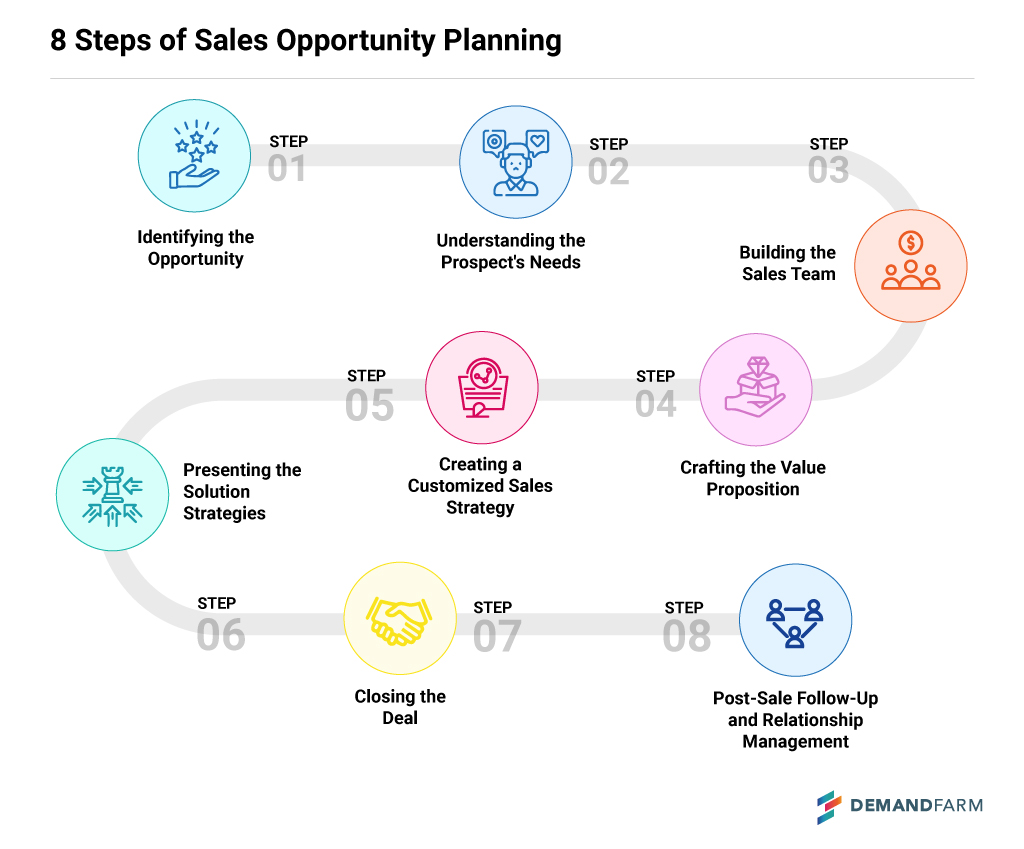Sales opportunity planning is a complex process that entails following several steps and requires a comprehensive guide. It’s built around a multi-step sales cycle with several stages that include research, qualification, and strategy development. All these stages are aligned to meet the common goal of realizing the full potential of a prospective sales opportunity. The success and future of any sales organization hinge on the cohesive planning and execution of each step, that is collectively known as sales opportunity management.
The best and most effective sales opportunity plans are created and aligned around creating value for the buyer. It also enables managers and sales teams strategize, plan, execute, and monitor a multistage sales process. Compared to managing a sales pipeline where metrics like revenue and margin take center stage, opportunity planning is a more complex process that is planned and executed around the customer. To understand the different facets and layers of this strategy, let’s look at the 8 steps of sales opportunity planning.

8 Steps of Sales Opportunity Planning
Step 1: Identifying the Opportunity
The journey starts with identifying the sales opportunity that is nothing else but a qualified sales lead. By meeting the necessary criteria, this lead presents the opportunity for business potential. You need to ask yourself some pertinent questions in order to identify valuable sales opportunities, such as:
- Are your existing customers seeking existing services or products that your competitors are not able to provide?
- Are there any new services or products that you can provide and gain market traction?
- Are there any customers that you may have not considered that are now available to you?
This process plays an important role in qualifying leads and sifting opportunities from dead ends. After identifying a set of opportunities, you can rank them on the basis of cost, potential benefit and complexity to implement.
Tools such as organizational charts and product roadmaps can play an important role in prospecting and lead generation. They help you to decode the prospect’s organizational structure and identify key decision-makers and stakeholders. In fact, product roadmaps are a great asset for sales teams to understand a product’s future capabilities and how they can match with the prospect’s needs.
Learn More: How to do Opportunity Management in Salesforce CRM
Step 2: Understanding the Prospect’s Needs
The buyer is the kingpin of the planning sales opportunities and the success of any plan hinges on understanding the prospect’s needs. Sellers must invest all time and energy into this crucial stage by meticulously researching the prospect’s pain points and goals. One way to identify opportunities for value creation is by conducting thorough customer discovery interviews. To gain a clear view of available opportunities, you must document the history with your customer and add possible future ones to the list.
Sales teams must invest in tools such as customer strategy maps to align their objectives and initiatives match with capabilities of the solution they are offering. These maps are a repository of the culture of customer organizations, their goals and possible challenges. With this vital information, your sales force can identify potential areas where you can provide value that boosts the customer’s plans.
Learn More: What are White Space Opportunities?
Step 3: Building the Sales Team
The next step in sales opportunity planning is to assess your organization for the business capabilities required to go after the opportunity. This crucial stage involves assembling a cross-functional sales team with the right skills and expertise. Roles and responsibilities must be clearly defined within the team and equally important is to ensure clear communication and collaboration among team members.
Apart from tracking the activities of your sales team, keep your ear close to the ground to gain insights from other team members. Innovative ideas and solutions may come from their personal insights into potential value for the buyer. A valuable or crucial tip may change the game and help sales teams close a sale, or resolve a difficult issue.
Step 4: Crafting the Value Proposition
Once you have a clear understanding of the buyer’s needs and your team is in place, you can focus on crafting your solution and building the value case. At this stage, it’s important to create a compelling value proposition that is tailored to the prospect and addresses the prospect’s specific needs and pain points. Another aspect of crafting the value proposition is showcasing the unique selling points and benefits. Ideally, each component of your proposition should be linked to the value it provides for the buyer. These points will help you appeal to the buyer’s needs and create effective value messaging.
Another important point to consider at this stage is how you compare with the competition from the buyer’s perspective. Understanding the buyer’s view of your competition will help you create a value proposition that highlights your strengths. Moreover, this value proposition can also cater to buyers that are not serviced well by your competition. Your value proposition can appeal to those needs the buyers that the competition does not service.
Step 5: Creating a Customized Sales Strategy
We have crossed the half-way mark of the sales opportunity plan and now is the time to develop a detailed sales plan, including timelines and milestones. You need to know the buyer’s buying process and match it to your sales process to create a customized sales strategy. It’s important to gather all valuable insights your team can contribute to formulating a winning sales strategy. Based on their success with customers, sales winners are likely propose winning ideas and also alert you about what does not work.
By incorporating insights and inputs, you can create a customized sales strategy to meet specific goals and objectives. Formulating a sales strategy also entails anticipating objections and challenges and preparing response strategies for each. The final action plan must map out the steps you need to take during the entire process to close the sale.
Step 6: Presenting the Solution Strategies
Planning a winning strategy is one thing but presenting a convincing solution strategy is a different matter altogether. When executed well, this step can create a lasting positive impression on the customer’s mind about your organization. Presentation is a vital skill and your team must be trained to deliver persuasive and engaging sales presentations. Your sales team can leverage storytelling and visuals to enhance the presentation. Plus, showcasing your logo design can help emphasize your brand identity and leave a memorable impression on the customer. Another useful tip is to tap into the power of AI tools that can help you address objections and concerns in real-time.
Step 7: Closing the Deal
Your planning and best efforts finally bear fruit at the stage when the deal is closed. The sales force needs to hone techniques for effective negotiation and closing to ensure that the deal goes through. Attention to detail must be the guiding mantra to formulate strategies for handling contract negotiations and finalizing agreements. Steps must be taken while planning the closing of the deal to ensure a smooth transition to post-sale activities. Adopting strategic agility will help your team adapt to changing market conditions and ensure positive results.
Step 8: Post-Sale Follow-Up and Relationship Management
The work of any sales force doesn’t culminate with the closing of a deal. Relationship management and retaining the customer is equally important and must include post-sale customer care and relationship building. You must have strategies in place for upselling and cross-selling, whereby you prompt customers to upgrade to a better product and opt for more complimentary products. Your aim should be delight loyal and satisfied customers with additional benefits to ensure they turn into your brand’s advocates and refer it to more potential buyers.
Learn More: What is Relationship Mapping?
Strive for Continuous Improvement
The best laid sales plans and strategies may not necessarily work entirely and the way forward involves iterative planning and refining strategies. Sales leaders must periodically review sales opportunity process and opt for course-correction when needed. This process of iterative planning also includes evaluation of the opportunity and also means evaluating whether the opportunity still exists and what the competition is bringing to the market. Any assumption made about the opportunity also needs to be tested to see if it is larger than you thought and if you need to reallocate your resources.
By using the right digital tools you can streamline the process of tracking sales opportunities at every stage of the sales process. You can leverage these tools to improve the collection and analysis of data on sales performance and identify trends as well as areas of improvement. The right templates and other aids also go a long way to close deals and help build long-term customer relationships.
DemandFarm’s Opportunity planning software is one such tool that assists sales teams to adopt a systematic and collaborative approach to identifying potential opportunities, planning a strategy, and closing large, complex enterprise deals.

